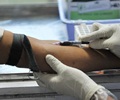The binding of a potent inhibitor of the hepatitis C virus (HCV) to the genetic material of the virus causes a major conformational change that may adversely affect the ability of the virus to replicate, a team of researchers has discovered. //
This discovery, published in the March 29 early edition of the Proceedings of the National Academy of Sciences, provides a potential new target for structure-based design of new hepatitis C treatments.Currently, the most effective treatment for hepatitis C is an agent called pegylated interferon, which is often combined with an antiviral drug called ribavirin.
"The available therapies for hepatitis C infection have limited effectiveness, with less than a 50 percent response," says Darrell R. Davis, Ph.D., the lead author and professor and interim chair of medicinal chemistry and professor of biochemistry at the University of Utah. "However, small molecules that inhibit viral replication have been reported and they represent potential opportunities for new, more effective HCV treatments."
HCV is a member of the Flaviviridae family of viruses, which also includes the viruses that cause yellow fever and dengue. There are six major genotypes of HCV, which differ slightly in their genetic constitution and vary in their response to treatment. HCV has a single strand of ribonucleic acid (RNA) as its genetic material and the virus replicates by copying this RNA. Previous research has shown that the three-dimensional structure of HCV RNA appears to be crucial for initiating the viral replication process.
Davis and his colleagues, including scientists from Isis Pharmaceuticals Inc., in Carlsbad, Calif., studied a potent small-molecule HCV replication inhibitor called Isis-11 to understand how it inhibits viral replication. They discovered that Isis-11 binds to a region of the viral RNA that is common to all six genotypes of HCV, altering the structure in a way that likely prevents the synthesis of viral proteins. The Isis-11 inhibitor effectively eliminated a bent RNA conformation that other laboratories have shown is required for the proper function of the HCV genomic RNA.
"Binding of Isis-11 resulted in a major conformational change in a specific region of HCV RNA that is thought to be critical for viral replication," says Davis. "This alteration in structure provides a possible mechanism for the antiviral activity of Isis-11 and other HCV replication inhibitors in that chemical class."
Advertisement
TRI













